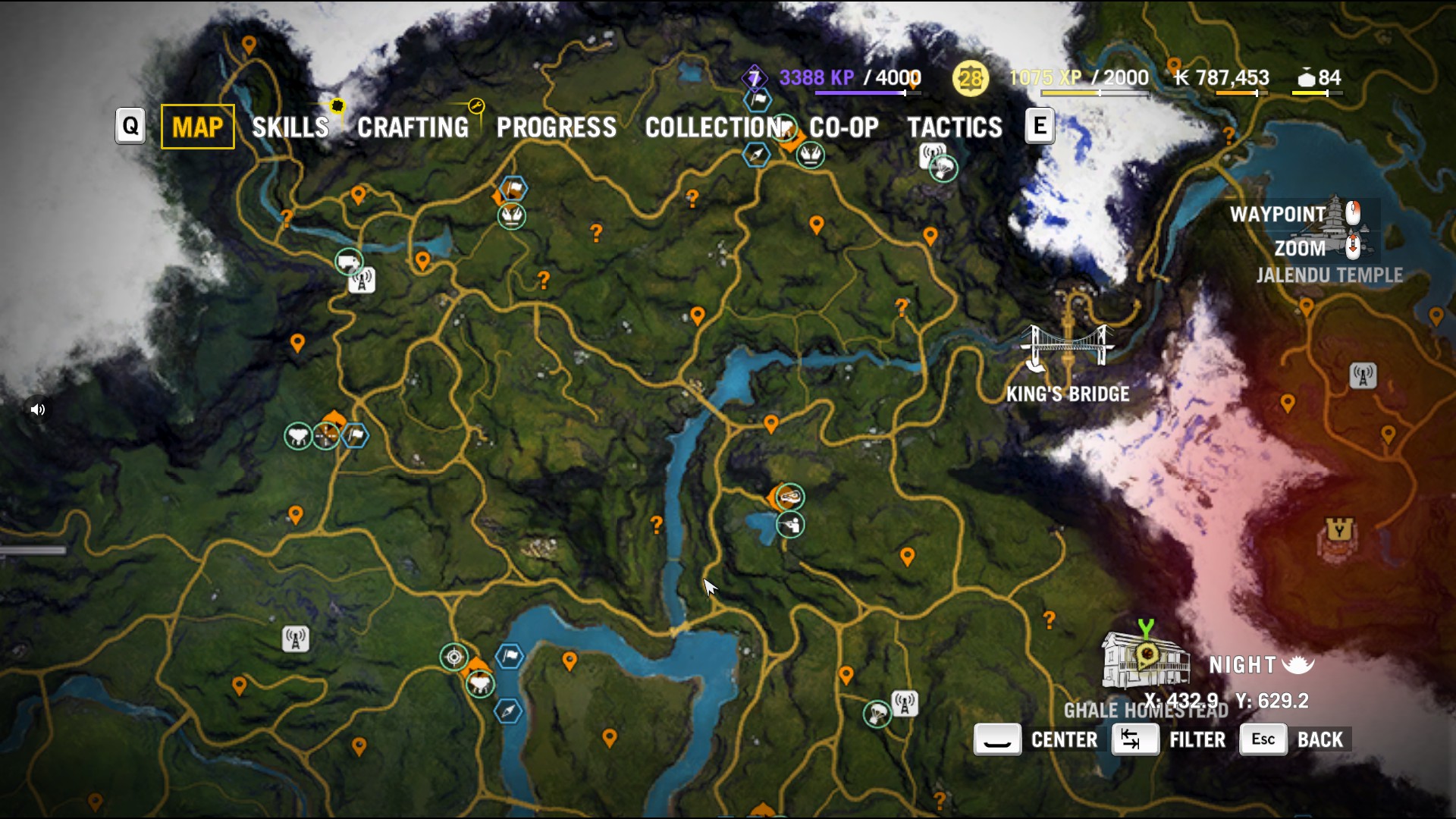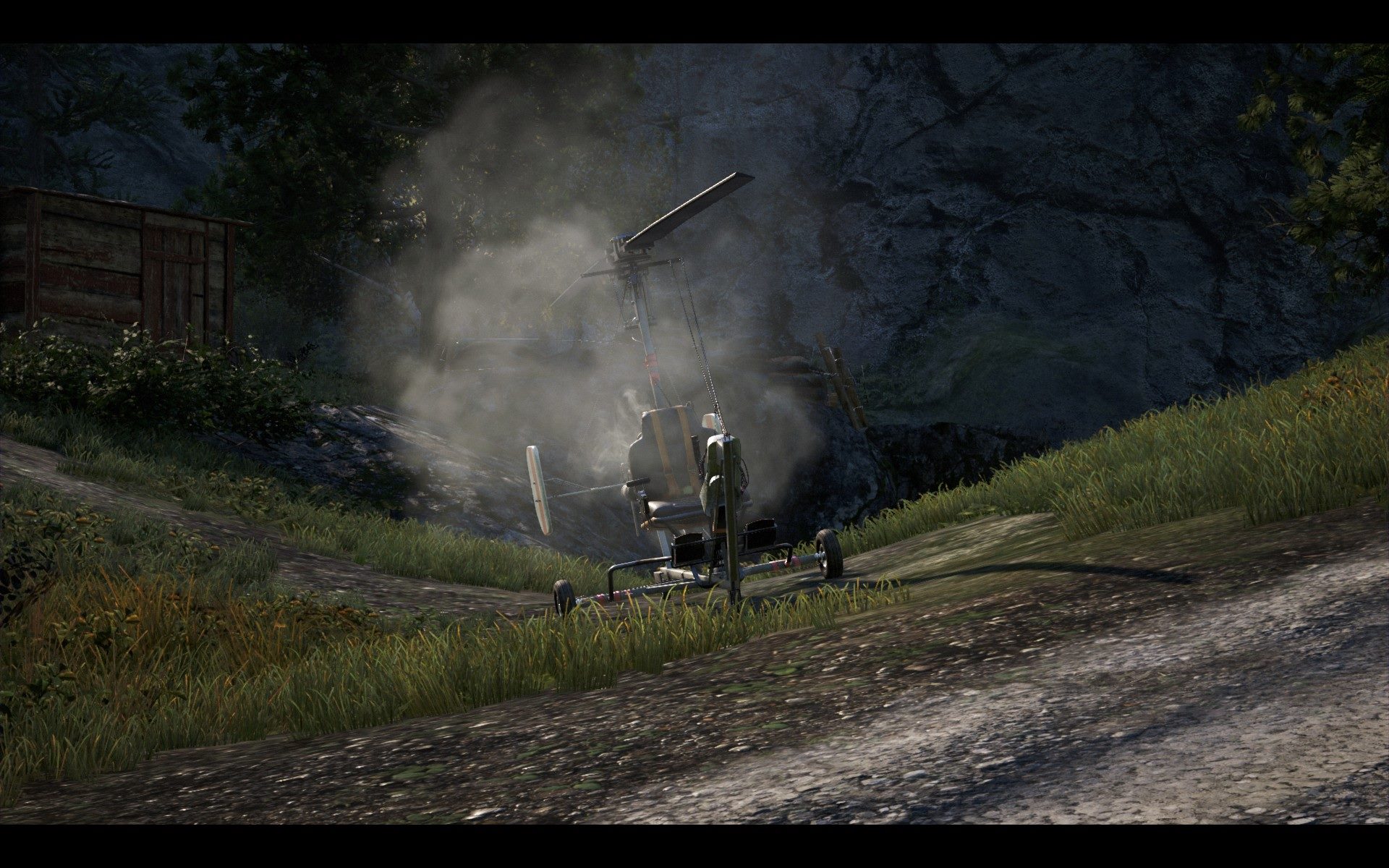My friend and I were playing Far Cry 4 last week when we had an experience neither of us will soon forget. We stumbled upon a stellar example of emergent gameplay. I'll tell you the story and then talk a little bit about what I've learned about the concept.
WARNING: There may be a spoiler or two in this article. I'm not saying anything explicit about the game's narrative, but a picture of a map may reveal information you don't want to know (or something like that). Tread carefully.
The Encounter
Far Cry 4, for those unaware, is an open-world first-person game set in the dangerous yet beautiful nation of Kyrat.
When my friend and I play, we go "question mark hunting." All the hidden caves, items, or places on the island that one has not stumbled upon show up as question marks on the map, like so:

Thus, we went on our merry way playing Dora the Explorer. One of us was Dora and the other was Boots. It was all tremendous fun, until we reached our next location. It looked like a hole in the ground covered with boards.

The First Try
The triangular space allowed me to squeeze through, so I did. I thought I might be able to attach the grappling hook as I fit through, but instead I failed magnificently. I slipped through the hole and fell to my death. In fact, here's a clip of what happened:
Clearly, dying is not the right way to reach the bottom. My friend crouched down with the intent of attaching the grappling hook first and then jumping down the hole. However, this is how it turned out, from my perspective:

The cable wrapped around odd places and he became a contortionist. However, he couldn't get down. Thus, we were left without options. Surely, it couldn't be this hard.
MacGyver It
My friend had a flash of inspiration. One of us could pilot a gyrocopter over the hole while the other hung below it via grappling hook. Once the chopper was in position, the man below could potentially lower himself into the hole and all the way to the bottom of the cavern. Here is our trusty method of locomotion:

Though I didn't record it the first time, my friend and I sat down to do a re-run and record it this time. Mind you, it was my first time doing game recording, so you'll have to forgive our occasional banter about that and other random subjects (I now know that "bow" is the front while "stern" and "aft" can both refer to the back of the ship). I also had a bit of a cold. Go to the 2 minute mark if you want to skip some discussion.
It was a little complicated, but in the end, it worked. Notice what happened at the end. I shot and broke the boards, and my friend could grapple down easily. In fact we could have done that when we first saw the boards. We were supposed to do that! What took us 25 minutes should have taken us 2. But you know what? I didn't regret a second of it. I'll remember this event for many years, probably because I was having fun. At some level, that's what every game aims to be: fun.
The Realization
Besides just being fun, I immediately realized this was a perfect example of emergent gameplay (which I promptly described to my friend). I wanted to do some more research regarding emergent gameplay, and so here we are.
Emergent gameplay is a scenario in which the simple rules or mechanics provided to a player can be utilized such that their combination creates new and/or unintended strategies. Utilizing the grappling hook of the chopper to bypass the destruction of the boards was an unintended method of descending into the hole. That said, my definition might also be a point of contention for some. It's debatable whether or not emergent gameplay has anything to do with the game designer's input.
For example, if the game designer provided a mechanic whose depth and complexity was massive but fully intended by the designer, is a player's discovery of this complex utility emergent? Some argue that true emergent gameplay arises when no part of the system can explain the complexity of the emergent property (like the rise and fall of market prices)1, which has nothing to do with the designer's intentions. In fact, Jochen Fromm theorized four types of emergence2, which I briefly review here:
Nominal or intentional emergence, which derives from systems with no feedback or only feedback on the same level. The example used is man-made machinery in which the function is a designed emergent property of the components, but lacks flexibility because of it.
Weak emergence introduces top-down feedback between levels of the system. Flock behavior of birds is an example of such emergence; birds react to the birds in their vicinity yet all of them move as a group.
Multiple emergence describes the complexity when multiple feedback loops interact at different levels of the system, such as in the stock market, or Conway's Game of Life.
Strong emergence is a little tough to immediately agree with, but it describes systems where the highest level of emergence is completely separate from its most atomic particles. The examples used are life as an emergent property of genetic systems and culture as an emergent property of language and writing. I feel the connection is a bit tenuous, but you can form your own opinion with more reading.
Regardless of how it is defined, emergent gameplay is fascinating because it's difficult to get right. It isn't something you can reverse-engineer or truly plan for. It's also difficult to accurately predict. If one were designing with the dream of emergent gameplay in mind, one would have to ensure that the game rewards the result and not the method. I'm sure many of you have played a game where you've gotten past some part of a level, but not in the intended way, and so something funny happens, like the enemies in the next sector fail to load (Sonic Heroes, anyone?). That's an example of rewarding method instead of result, and that denies emergence (or freedom, if you view emergence differently). The design can be much more involved than that, but I would suggest reading the second article in the source list below for more.
Summary
Though this post was more an opportunity for me to tell a story and explore a topic I developed an interest in, I hope it was of some value to you. Emergent gameplay, while difficult, is not something I would write off as immediately out of reach. Next time you are designing some game mechanics, think about how you might relax the rules to provide some feedback or interplay. I've included some sources for further reading because I only scratched the surface here. The comments of the first article are truly engaging; I would take my time there. The second link is a research article examining emergent gameplay and how game systems can be visualized with UML (Unified Modeling Language). Both are excellent reads.
